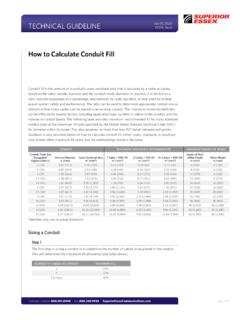Transcription of Body Mass Index: Considerations for Practitioners
1 Body Mass Index: Considerations for Practitioners What is BMI? Body mass index (BMI) is a measure of weight adjusted for height, calculated as weight in kilograms divided by the square of height in meters (kg/m2). Although BMI is often considered an indicator of body fatness, it is a surrogate measure of body fat because it measures excess weight rather than excess fat. Despite this fact, studies have shown that BMI is correlated to more direct measures of body fat, such as underwater weighing and dual energy x-ray absorptiometry. Why use BMI? BMI is a simple, inexpensive, and noninvasive surrogate measure of body fat.
2 In contrast to other methods, BMI relies solely on height and weight and with access to the proper equipment, individuals can have their BMI routinely measured and calculated with reasonable accuracy. Furthermore, studies have shown that BMI levels correlate with body fat and with future health risks. High BMI predicts future morbidity and death. Therefore, BMI is an appropriate measure for screening for obesity and its health risks. Lastly, the widespread and longstanding application of BMI contributes to its utility at the population level. Its use has resulted in an increased availability of published population data that allows public health professionals to make comparisons across time, regions, and population subgroups.
3 What are some issues to consider when using BMI for adults? The clinical limitations of BMI should be considered. BMI is a surrogate measure of body fatness because it is a measure of excess weight rather than excess body fat. Factors such as age, sex, ethnicity, and muscle mass can influence the relationship between BMI and body fat. Also, BMI does not distinguish between excess fat, muscle, or bone mass, nor does it provide any indication of the distribution of fat among individuals. The following are some examples of how certain variables can influence the interpretation of BMI: On average, older adults tend to have more body fat than younger adults for an equivalent BMI.
4 On average, women have greater amounts of total body fat than men with an equivalent BMI. Muscular individuals, or highly-trained athletes, may have a high BMI because of increased muscle mass. What are some issues to consider when using BMI for children and adolescents? The concerns associated with using BMI for adults also apply to children and adolescents. Other factors, including height and level of sexual maturation, influence the relationship between BMI and body fat among children as well. In addition, the accuracy of BMI varies substantially according to the individual child s degree of body fatness.
5 Among obese children (or a BMI-for-age greater than or equal to the 95th percentile), BMI is a good indicator of excess body fat. However, among overweight children (or a BMI-for-age between the 85th and 94th percentiles), elevated BMI levels can be a result of increased levels of either fat or fat-free mass. Similarly, among relatively thin children, differences in BMI are often due to differences in fat-free mass. How should different BMI levels for adults be interpreted? For adults 20 years and older, BMI is interpreted by using standard weight status categories that are the same for all ages and for both men and women.
6 The standard weight status categories associated with BMI ranges for adults are: BMI Weight Status Below Underweight Normal Overweight and Above Obese Research has shown that individuals with a higher BMI are more likely to experience obesity-related health problems. Although some debate continues about whether different categories should exist for specific subgroups (such as Asians), these BMI categories are used worldwide for all adults 20 years and older. Because no single body fat measure clearly distinguishes health from disease or risk of disease, BMI should serve as the initial screening of overweight and obesity for adults.
7 Health care providers should recognize that other factors, such as fat distribution, genetics, and fitness level, contribute to an individual s assessment of disease risk. How should different BMI levels for children and adolescents be interpreted? BMI is calculated the same way for adults and children, but the results are interpreted differently. For adults, BMI classifications do not depend on age or sex. For children and adolescents between 2 and 20 years old, BMI is interpreted relative to a child s age and sex, because the amount of body fat changes with age and varies by sex.
8 Percentiles specific to age and sex classify underweight, healthy weight, overweight, and obesity in children. The BMI-for-age determined for an individual indicates the relative position of the child s BMI value among children of the same sex and age. BMI-for-age categories and corresponding percentiles are: Need more information? Visit the following websites: For general BMI information: For an adult BMI calculator: For a child and adolescent BMI calculator: For BMI resources for schools: Percentile Ranking Weight Status Less than 5th percentile Underweight 5th percentile to less than 85th percentile Healthy weight 85th percentile to less than 95th percentile Overweight Equal to or greater than the 95th percentile Obese BMI should serve as an initial screening for children and adolescents.
9 A health care provider should integrate other factors into a health assessment, including evaluations of diet, physical activity, family history, and other appropriate health screenings. What other measures of body fat are available? Some research suggests that other measures of body fat, such as skinfold thicknesses, bioelectrical impedance, underwater weighing, and dual energy x-ray absorption, may be more accurate than BMI. The waist circumference (sometimes divided by height) is also a simple measure of fat distribution. Although these measures may provide a better indication of an individual s body fatness and risk of obesity-related health problems, they can be expensive, intrusive, not widely available, or difficult to standardize across observers or machines.
10 Some of these measures are considered inappropriate for routine clinical practice because they are technically demanding and rely on more complex technologies. In addition, most of our knowledge concerning obesity-related health risks is based on the association of BMI to various outcomes. There are few reference standards for body fatness based on the above-mentioned measures, and without established risk categories, it is difficult to determine if the body fatness of an individual is low, moderate, or high. Consequently, other measures of body fat are not recommended for routine practice.














